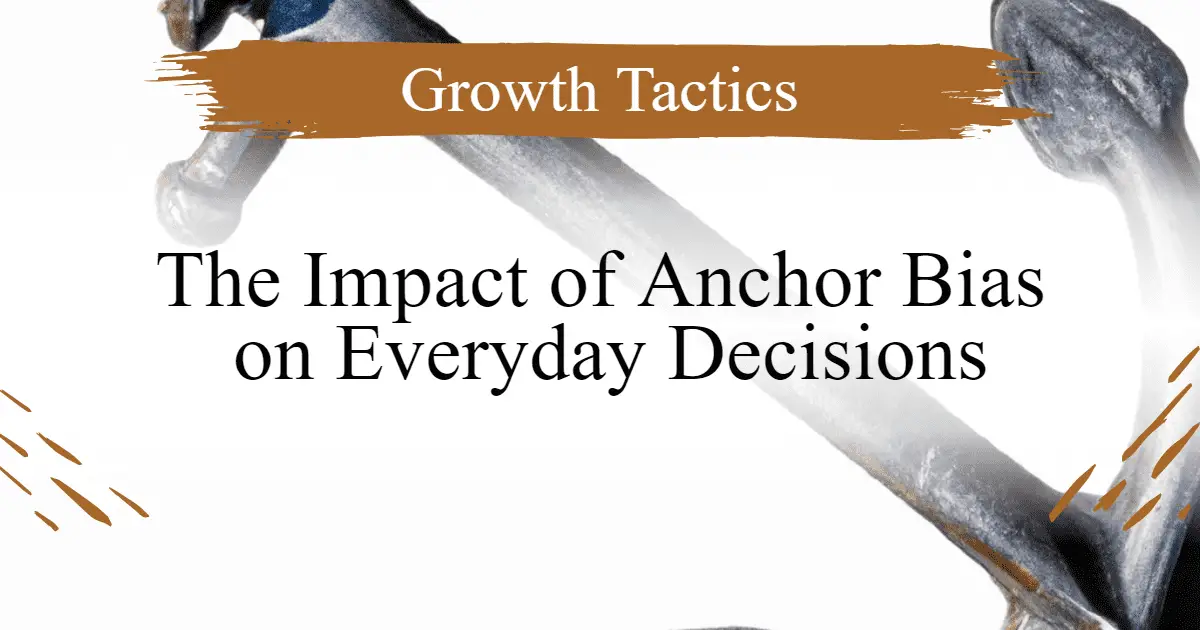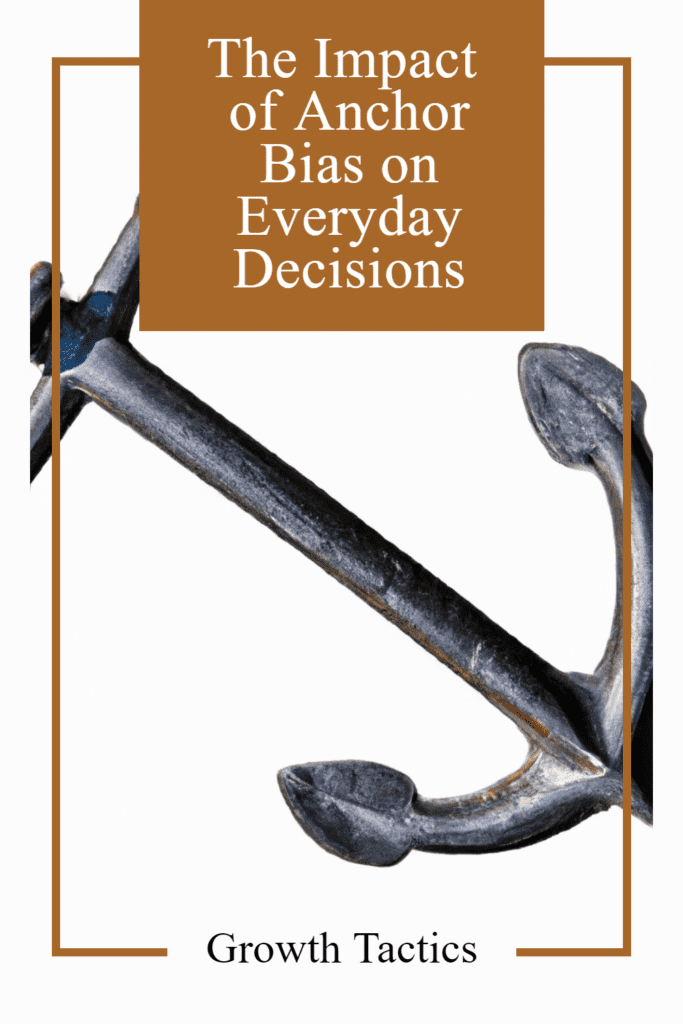Anchor bias, also known as anchoring bias, is a cognitive bias that affects our decision-making process. It describes our human tendency to rely heavily on the first piece of information we encounter (the ‘anchor’) when making decisions. Whether we’re aware of it or not, the initial information we come across sets a mental precedent that can thereafter influence our estimations, perceptions, and judgments.
The concept of anchor bias might seem esoteric, but its footprint can be traced in our everyday decision-making. From choosing which product to buy to making career choices, to wagering financial risks, and even determining our state of health, the ghost hand of anchor bias subtly nudges us one way or another. Its pervasive influence underscores the importance of understanding this bias in order to navigate our complex world in a more informed and objective manner.
Understanding Anchoring Bias: What is it exactly?
Anchor bias, or the anchoring effect, is a cognitive bias that influences judgment. It refers to a human tendency to rely too heavily on the initial piece of information, the “anchor,” when making decisions. For example, if you are asked to guess the percentage of African countries in the United Nations and originally given a low introductory figure, such as 10%, you may guess a lower final percentage than if you had initially been given a higher reference point, say 60%. This demonstrates how cognitive bias can skew our understanding of information and influence our decision-making.
The Cognitive Architects: An Introduction to Tversky and Kahneman
Amos Tversky and Daniel Kahneman, prominent psychologists, first introduced the theory of anchoring bias in their influential 1974 paper, “Judgment Under Uncertainty: Heuristics and Biases”. Their extensive research looked into various cognitive biases and sparked a new conversation in the realms of psychology and behavioral economics. Both their research and their contributions laid important groundwork for the field of decision-making psychology.
The Original Study (1974): Birth of the Anchoring Bias Concept
In the landmark study published in 1974, Tversky and Kahneman demonstrated the effects of anchor bias using an intriguing method. Participants were asked to spin a wheel with numbers between 0 and 100. Then, the subjects were requested to guess whether the percentage of African countries in the UN was higher or lower than the number they spun on the wheel. Finally, they were asked to provide their best estimate of the exact percentage. The study found that subjects’ final answers were significantly swayed by the arbitrary number they originally spun on the wheel, thus highlighting the influence of the anchor in their decision-making.
The Mechanics of Anchoring Bias: How Does it Work?
Anchoring bias works with a simple yet potent rule – the first piece of information that we come across, the ‘anchor’, has considerable sway over our judgment. It skews our thought process and decision-making as we tend to make adjustments that are insufficient, based on this initial value without enough regard for subsequent pieces of information. Kahneman termed this insufficient adjustment phenomenon – anchoring and adjustment.
An interesting point to note here is that even when the anchor holds no relevance to the decision at hand, it can still strongly influence the outcome – this is a testament to the anchor bias’s enduring power.
Anchoring Bias in Action: Real-World Examples
Anchor Bias in Business Negotiations
Anchoring bias is not just a psychological concept restricted to laboratory conditions or textbook definitions. Its footprints can be traced in various real-world situations, particularly in business negotiations. When two parties engage in a negotiation, typically one party lays down the first offer. This initial offer, regardless of its relevance or accuracy, tends to “anchor” the dialogue.
For example, let’s consider a job salary negotiation. If the employer starts with an offer of $50,000 per year, that figure sets the benchmark for subsequent negotiations. Even if the potential employee had hoped for much higher, the initial offer acts as an anchor, and subsequent discussions are influenced by this first figure, despite it being potentially lower than the industry average or the candidate’s qualifications.
This demonstrates that the first figure that surfaces in a negotiation not only has the potential to sway the possibility of a final agreement but may mold the entire negotiation process.
Anchoring Bias in Retail Shopping
Similarly, in a retail environment, anchoring bias is ubiquitous. Let’s imagine a scenario. A jacket was initially priced at $200, but now, it’s marked as “discounted” at $100. The original price ($200) acts as an anchor, making the discounted price seem like a bargain irrespective of the product’s actual worth or your initial willingness to pay that amount.
Here, the anchor influences your buying decision, persuading you to perceive the transaction as a favorable deal. You might end up buying the jacket influenced by the perceived savings rather than genuine need or product value.
Individual Differences in Susceptibility to Anchoring Bias
Research in the field of psychology has observed that the effect of anchoring bias is not uniform across all individuals. In other words, some people are more susceptible to anchoring bias than others. This variance in susceptibility can be attributed to several factors. Let’s delve into these factors for a clearer understanding of their roles:
- Familiarity with the Domain of Judgment: The extent of one’s familiarity with the subject or domain at hand plays a significant role in determining the degree of anchoring bias. Individuals who possess a greater understanding or experience in the particular domain are generally less prone to this bias. For instance, a professional wine collector might be less influenced by arbitrary price anchors when purchasing wine compared to an amateur who lacks knowledge in this area.
- Level of Critical Thinking: Critical thinking, the ability to analyze and objectively assess information, is a significant determinant of susceptibility to anchoring bias. Individuals who exercise high levels of critical thinking are often more capable of recognizing the potential influence of an anchor and thus, can better manage its impact on their judgments or decisions.
- Numeracy Skills: Numeracy, or numerical literacy, can also influence susceptibility to anchoring bias. Those with stronger numeracy skills are usually better able to process and evaluate numerical information independently of an anchor, reducing the likelihood of this bias skewing their decisions.
- Susceptibility to Other Biases: Particular cognitive biases can reinforce each other. For example, the confirmation bias (a tendency to selectively seek and favor information that confirms one’s pre-existing beliefs) can strengthen the anchoring bias. If an individual is inclined towards confirmation bias, they might unknowingly seek information that aligns with their anchored thinking, adding another layer of bias to their decision-making process.
Understanding these contributing factors can potentially enable individuals to identify situations or domains where they may be exceptionally susceptible to anchoring bias. By acknowledging their vulnerability, they can equip themselves with knowledge and strategies that help reduce the undue influence of initial information, thereby nurturing more robust decision-making abilities.
The Influence of Anchor Bias: A Comprehensive Look
Understanding the anchoring bias can help us comprehend why and how our decision-making and impressions can be influenced. The influence of anchoring bias is found everywhere, from our daily purchasing decisions to our overall perceptions of complex situations. For instance, our judgment around reasonable spending can be anchored by the initial price of products.
Notably, the influence of the anchoring effect extends to professional settings as well, such as negotiations, where the first offer mentioned tends to act as an anchor and dictate the direction of further bargaining.
The Danger of Anchoring: How Can it Lead to Poor Decision-Making?
While anchoring effects can appear harmless or even beneficial in certain situations, bias can lead to poor decision-making. Given our natural propensity to accept the first piece of information as a reference point, we can easily be swayed into making judgments or decisions that might not be in our best interest.
For example, in medical diagnoses, if a doctor is anchored to an initial diagnosis based on early symptoms, they might overlook other symptoms that could point to a different health condition. Thus leading to wrong treatment plans. That’s why understanding our susceptibility to anchoring and striving to correct for it is crucial in decision-making under uncertainty.
Recognizing and Avoiding Anchor Bias: Practical Strategies
The first step to avoiding anchoring bias is awareness. By cultivating a conscious understanding of how anchor bias operates, individuals can take practical measures to reduce its impact on their decision-making. Here are some strategies:
- Expose yourself to diverse perspectives: To counter the limitations imposed by relying on the first piece of information, gather a broader range of opinions and data before drawing conclusions or making a decision.
- Challenge your initial thoughts: Pause and ask if the given anchor is relevant, or simply a biasing factor. Be prepared to question initial judgments, and consider alternatives.
- Delay the decision-making process: Allowing time to pass before making a decision allows for a more thorough contemplation of the available information, thereby reducing the influence of the anchor.
How Does the Understanding of Anchoring Bias Improve Decision-making?
By being aware of the anchoring bias and actively taking steps to minimize its influence, one can make more informed decisions that are less dependent on arbitrary anchors. This knowledge can help you not only recognize and avoid potential cognitive traps but also empower you with the ability to anticipate and adapt to the anchoring biases of others. This can be particularly beneficial in contexts like negotiations, where understanding the other party’s biases play a critical role in achieving desired outcomes.
Undoubtedly, a deeper understanding of the anchoring effect will enhance your decision-making process, fostering better choices in both personal and professional spheres, free from unnecessary limitations.
To sum up, the most important takeaways from this blog post are:
- Anchoring bias refers to the tendency to rely too heavily on the first piece of information encountered when making decisions
- Amos Tversky and Daniel Kahneman initially introduced this concept in 1974
- Anchoring bias can influence various aspects of life, including professional settings and day-to-day decisions
- Individual susceptibility to anchoring bias can vary
- Understanding and mitigating anchoring bias can lead to more informed and objective decision-making.
In conclusion, the exploration of anchoring bias offers valuable insights into the workings of the human mind and equips curious learners with a better understanding of their cognitive landscape. The knowledge gained from this blog post will empower you to make decisions that are more informed, objective, and free from cognitive traps.


